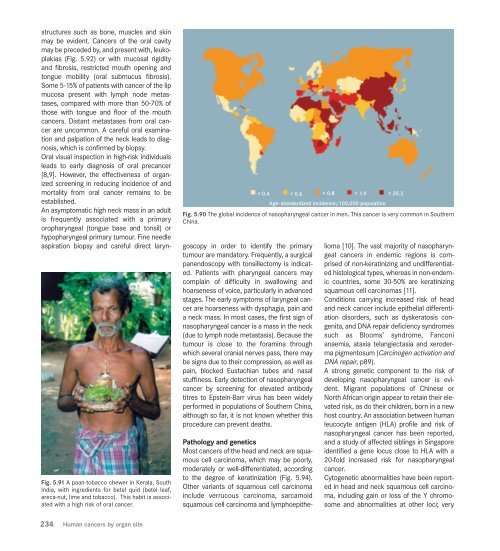world cancer report - iarc
world cancer report - iarc
world cancer report - iarc
Create successful ePaper yourself
Turn your PDF publications into a flip-book with our unique Google optimized e-Paper software.
structures such as bone, muscles and skin<br />
may be evident. Cancers of the oral cavity<br />
may be preceded by, and present with, leukoplakias<br />
(Fig. 5.92) or with mucosal rigidity<br />
and fibrosis, restricted mouth opening and<br />
tongue mobility (oral submucus fibrosis).<br />
Some 5-15% of patients with <strong>cancer</strong> of the lip<br />
mucosa present with lymph node metastases,<br />
compared with more than 50-70% of<br />
those with tongue and floor of the mouth<br />
<strong>cancer</strong>s. Distant metastases from oral <strong>cancer</strong><br />
are uncommon. A careful oral examination<br />
and palpation of the neck leads to diagnosis,<br />
which is confirmed by biopsy.<br />
Oral visual inspection in high-risk individuals<br />
leads to early diagnosis of oral pre<strong>cancer</strong><br />
[8,9]. However, the effectiveness of organized<br />
screening in reducing incidence of and<br />
mortality from oral <strong>cancer</strong> remains to be<br />
established.<br />
An asymptomatic high neck mass in an adult<br />
is frequently associated with a primary<br />
oropharyngeal (tongue base and tonsil) or<br />
hypopharyngeal primary tumour. Fine needle<br />
aspiration biopsy and careful direct laryn- goscopy in order to identify the primary<br />
tumour are mandatory. Frequently, a surgical<br />
panendoscopy with tonsillectomy is indicated.<br />
Patients with pharyngeal <strong>cancer</strong>s may<br />
complain of difficulty in swallowing and<br />
hoarseness of voice, particularly in advanced<br />
stages. The early symptoms of laryngeal <strong>cancer</strong><br />
are hoarseness with dysphagia, pain and<br />
a neck mass. In most cases, the first sign of<br />
nasopharyngeal <strong>cancer</strong> is a mass in the neck<br />
(due to lymph node metastasis). Because the<br />
tumour is close to the foramina through<br />
which several cranial nerves pass, there may<br />
be signs due to their compression, as well as<br />
pain, blocked Eustachian tubes and nasal<br />
stuffiness. Early detection of nasopharyngeal<br />
<strong>cancer</strong> by screening for elevated antibody<br />
titres to Epstein-Barr virus has been widely<br />
performed in populations of Southern China,<br />
although so far, it is not known whether this<br />
procedure can prevent deaths.<br />
Fig. 5.91 A paan-tobacco chewer in Kerala, South<br />
India, with ingredients for betel quid (betel leaf,<br />
areca-nut, lime and tobacco). This habit is associated<br />
with a high risk of oral <strong>cancer</strong>.<br />
234 Human <strong>cancer</strong>s by organ site<br />
< 0.4<br />
< 0.6<br />
Fig. 5.90 The global incidence of nasopharyngeal <strong>cancer</strong> in men. This <strong>cancer</strong> is very common in Southern<br />
China.<br />
Pathology and genetics<br />
Most <strong>cancer</strong>s of the head and neck are squamous<br />
cell carcinoma, which may be poorly,<br />
moderately or well-differentiated, according<br />
to the degree of keratinization (Fig. 5.94).<br />
Other variants of squamous cell carcinoma<br />
include verrucous carcinoma, sarcamoid<br />
squamous cell carcinoma and lymphoepithe-<br />
< 0.8<br />
< 1.9<br />
Age-standardized incidence/100,000 population<br />
< 25.2<br />
lioma [10]. The vast majority of nasopharyngeal<br />
<strong>cancer</strong>s in endemic regions is comprised<br />
of non-keratinizing and undifferentiated<br />
histological types, whereas in non-endemic<br />
countries, some 30-50% are keratinizing<br />
squamous cell carcinomas [11].<br />
Conditions carrying increased risk of head<br />
and neck <strong>cancer</strong> include epithelial differentiation<br />
disorders, such as dyskeratosis congenita,<br />
and DNA repair deficiency syndromes<br />
such as Blooms’ syndrome, Fanconi<br />
anaemia, ataxia telangiectasia and xeroderma<br />
pigmentosum (Carcinogen activation and<br />
DNA repair, p89).<br />
A strong genetic component to the risk of<br />
developing nasopharyngeal <strong>cancer</strong> is evident.<br />
Migrant populations of Chinese or<br />
North African origin appear to retain their elevated<br />
risk, as do their children, born in a new<br />
host country. An association between human<br />
leucocyte antigen (HLA) profile and risk of<br />
nasopharyngeal <strong>cancer</strong> has been <strong>report</strong>ed,<br />
and a study of affected siblings in Singapore<br />
identified a gene locus close to HLA with a<br />
20-fold increased risk for nasopharyngeal<br />
<strong>cancer</strong>.<br />
Cytogenetic abnormalities have been <strong>report</strong>ed<br />
in head and neck squamous cell carcinoma,<br />
including gain or loss of the Y chromosome<br />
and abnormalities at other loci; very

















